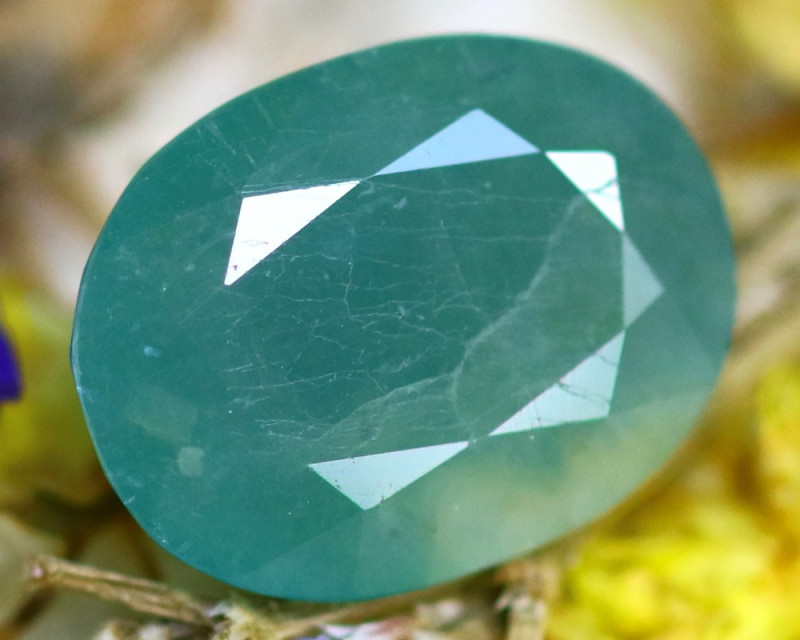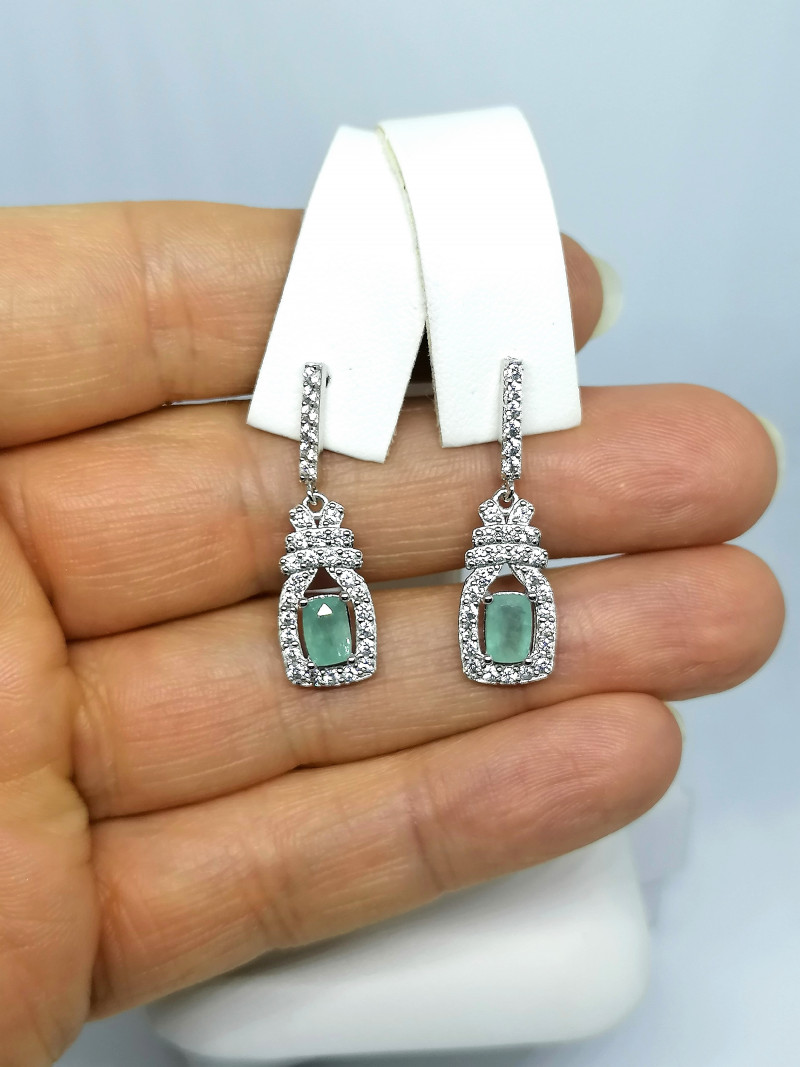
Grandidierite Gemstone: Properties, Meanings, Value & More
 Grandidierite (gran-dih-dee-er-aite) is a rare aquamarine-blue to sea-green gemstone. It’s mostly known among collectors, more than everyday gem buyers. But one look at grandidierite will show you that it’s not a gem to pass over!
Grandidierite (gran-dih-dee-er-aite) is a rare aquamarine-blue to sea-green gemstone. It’s mostly known among collectors, more than everyday gem buyers. But one look at grandidierite will show you that it’s not a gem to pass over!
Just how rare is grandidierite? Extremely rare. To put it in perspective, the Gemological Institute of America (GIA) reported that, before summer 2015, gem-quality grandidierite crystals big enough to be faceted were “almost unheard of.”
Among the rarest gemstones in the world, grandidierite often makes top ten and even sometimes top five lists.
So, is grandidierite a good investment? What makes it unique? By the end of this guide, you’ll know all the answers you need to determine if grandidierite is a gem for you!

What Is The Gemstone Grandidierite?
First, is grandidierite a precious stone? No, grandidierite is a semi-precious gemstone, though it’s rarer and usually more expensive than the four precious gemstones (diamond, emerald, ruby, and sapphire).
Though it’s not a more affordable alternative, grandidierite can substitute zircon as a traditional December birthstone or aquamarine as a March birthstone. Grandidierite cabochons can also resemble jade, making them substitutable as an August birthstone as well.
The gem’s blue and green tones mean that grandidierite can be used as a zodiac stone for earth signs (Taurus, Virgo, and Capricorn) and air signs (Gemini, Libra, and Aquarius).
Mineral-wise, what kind of stone is grandidierite?

Grandidierite Specifications & Characteristics
Grandidierite is a magnesium aluminum borosilicate stone. The exact formula varies by source, sometimes written as (Mg,Fe)Al3BSiO9, other times as (Mg,Fe)Al3(BO4)(SiO4)O, and still other times as (Mg,Fe2+)(Al,Fe3+)3(SiO4)(BO3)O2.
The (Mg,Fe) part of its composition accounts for the frequent presence of iron and manganese impurities. Other impurities include titanium, sodium, and potassium, but iron causes the characteristic blue-green hue.
Speaking of which, grandidierite’s color is the first key to its identification. The stone only occurs in shades of blue, green, or blue-green. The stone’s pleochroism (ability to display different colors from different viewing angles) is also a distinguishing feature.
However, lazulite has similar coloring and similar pleochroic colors. Grandidierite has a slightly higher Mohs hardness (lazulite is 5.5-6), but lazulite has a higher refractive index (1.60-1.66) and density (3.08-3.83).
Here are the remaining grandidierite mineral properties:
Mohs hardness: 7.5
Color: Blue, green, blue-green, green-blue
Crystal structure: Orthorhombic
Luster: Vitreous (glassy), pearly on cleavage
Transparency: Transparent to opaque
Refractive index: 1.58-1.63
Density: 2.85-3.00
Cleavage: Perfect on [100]; Good/Distinct on [010]
Fracture: Uneven
Streak: White
Luminescence: None
Pleochroism: Present and strong in dark green, colorless/pale yellow, and dark blue-green
Now that you know the mineralogy, it’s time to get into the symbolism and history of grandidierite!

Grandidierite Stone Meaning & History
Though it’s been known for over 100 years, grandidierite is still considered a modern stone. Given its modern nature, not much folklore is associated with it. That said, some believe grandidierite symbolizes resilience, mental clarity, and self-confidence.
Discovering and Naming Grandidierite
Grandidierite’s first official discovery occurred in Madagascar in 1902. French mineralogist and geologist Alfred Lacroix (no relation to the sparkling drink) discovered the stone and named it after another Alfred, the French explorer and naturalist Alfred Grandidier.
Honoring Grandidier for a Madagascar-based stone made sense, as Grandidier’s life work was a 38-volume encyclopedia of sorts on Madagascar’s geography and geological history. According to Cambridge History of Africa, this was the first detailed description of Madagascar.
If you’re interested, the 1885 book is titled Histoire physique, naturelle et politique de Madagascar, translated as Physical, natural and political history of Madagascar.
Modern Discoveries
In 2002, geologists discovered an iron-rich, blue stone called ominelite that forms a series with grandidierite as the iron-dominant counterpart (with grandidierite as the magnesium-dominant analogue). Ominelite’s formula is (Fe2+,Mg)(Al,Fe3+)3(SiO4)(BO3)O2 and it has a slightly higher density than grandidierite.
The specific location of Lacroix’s discovery was a pegmatite outcrop in Cap Andrahomana in southern Madagascar. This was the only known source of grandidierite until the 2000s. Transparent grandidierite from Sri Lanka was discovered in 2000, and another gem-quality deposit in Madagascar near Tranomaro was discovered in 2014.
After the Tranomaro discovery, gem dealer Brice Gobin collected around 20 grandidierite gems from the region, three of which were put on display in New York City. That said, the Tranomaro deposit has only produced around 300 carats of gem-quality material.
Moving on from the past, what is grandidierite good for now?

Grandidierite Healing Properties
All gemstones can function as healing stones, with some of their powers tied to their coloring. Bluer grandidierite stones have the benefits of blue gemstones, like soothing emotions and raising intuition.
Meanwhile, green gems like greener grandidierites with stronger green hues offer abundance, good luck, and optimism.
What about the physical, emotional, and chakra grandidierite benefits?
Physical Healing
Crystal healers recommend grandidierite for:
Blood circulation
Heart health
Immune system function
Infections, colds, and viral diseases
What about emotional healing?
Emotional Healing
Emotionally, grandidierite crystals are said to broaden your perspective and increase emotional resilience. They can also boost confidence, logical thinking, and relaxation.
Chakra Healing
Chakra healing involves opening a blocked energy point (chakra) to resolve negative symptoms. Grandidierite chakra stones open the heart and throat chakras.
The heart chakra governs love and acceptance. After using grandidierite to open it, feelings of detachment transform into self-love and compassion.
The throat chakra rules how you understand and communicate your truth. Blocked symptoms include shutting yourself off from others and social anxiety. Opening the chakra with grandidierite is helpful for self-expression and confidence, especially before giving a big speech or presentation!
Besides healing value, is grandidierite valuable as a gemstone?

Grandidierite Gemstone Properties
Grandidierite’s value primarily comes from its rarity, but it’s graded on color, cut, clarity, transparency, and carat weight.
Color
Grandidierite’s color is always blue, green, or a combination of these hues. The shade can vary from pale to dark, though saturated neon blues are most valuable.
The cause of grandidierite’s color is its frequent iron impurities. Higher iron content means richer tones.
Cut
Most high-quality grandidierite is faceted, often in round, oval, or octagonal shapes. The stone has strong dispersion (colorful sparkle), so faceted cuts display this quality best. Because of its birefringence, though, you may see a doubling of facets.
Opaque or semi-translucent stones usually become cabochons, with the latter making attractive options sometimes resembling jade. The stone can also be carved.

Clarity & Transparency
Clarity represents the amount of visible inclusions in a stone. Eye-clean grandidierite (meaning no visible inclusions to the naked eye) is highly valuable.
That said, some common inclusions in grandidierite are:
Two-phase vapor & liquid inclusions
Parallel growth planes
Needle-like passages
Crystals (namely monazite, apatite, and zircon)
Most grandidierite gems are translucent, though opaque rough is most common. Because opaque grandidierite is less rare, it’s more affordable while transparent stones are most valuable.
Carat Weight
Grandidierite cabochons can be 1-10 carats. Though the largest faceted specimen weighs 763.5 carats, most faceted grandidierites are under 5 carats. Madagascar has produced crystals as large as 8 cm (3.14 in) in length.
Synthetics
Grandidierite isn’t treated, but it can be manufactured. Usually, scientists create synthetic grandidierite for research — it’s not as common in jewelry.
Because of its rarity, some sneaky sellers may try to pass other stones off as grandidierite. These are called simulants or fake grandidierites.
Looking back at the real deal, how does natural grandidierite form?

Grandidierite Formation & Sources
Raw grandidierite forms inside pegmatites. As the pegmatites form from cooling magma, crevices form inside from gas bubbles and different cooling rates. This allows for water containing melted mineral elements to seep into the crevices and harden into crystals.
Grandidierite crystals are found mostly in pegmatites but also in aplites, xenoliths, and gneisses.
Now, where does grandidierite come from?
Mining Locations
Though Madagascar was the sole source for a long time, high-quality grandidierite has since been found in Sri Lanka.
Additional sources include:
Algeria
Antarctica
Australia
Canada
Czechia
Germany
Greenland
India
Italy
Malawi
Namibia
New Zealand
Norway
Scotland
Slovakia
South Africa
Suriname
USA (New York, Wyoming)
Zimbabwe
While grandidierite has been found in these locales, no locations besides Madagascar have produced notable amounts of gem-quality grandidierite.
With that in mind, what is grandidierite worth?

Grandidierite Stone Price & Value
The most expensive and hard-to-come-by grandidierites for sale are transparent, saturated in color, and eye-clean. The first faceted, transparent grandidierite (sold in 2003) was only 0.29 carats and fetched $50,000 (around $172,000 per carat).
In general, the grandidierite price per carat for transparent to translucent faceted stones with good clarity is about $20,000-$26,000 per carat.
At wholesale, grandidierite cabochons are much more affordable, ranging from $5-$10 per carat, though some reach beyond $2,000 per carat. Carvings at wholesale start at $2 per carat.
With investment-level prices, proper gemstone care is of utmost importance.
Grandidierite Care and Maintenance
Grandidierite stones are pretty durable, so any jewelry option is wearable. Because of their perfect cleavage, though, we recommend choosing grandidierite jewelry with protective settings.
Don’t wear grandidierite jewelry during intense activities, so you can avoid potential hard blows or fractures to the stone. To clean the stone, the standard soft toothbrush, mild soap, and warm water will do the trick.

Grandidierite: A Rare, Grand Delight!
Grandidierite is a top-tier find for anyone who’s passionate about crystals or collecting rare gems. With every small deposit of grandidierite crystals depleting quickly, it’s surely a worthy investment.
If grandidierite is beyond your budget, some similar-looking alternatives are aquamarine, chalcedony, apatite, or spinel. You can also see some gorgeous grandidierite gems on display at Wilensky Gallery in New York City.
For those seeking these one-of-a-kind crystals, we have them available here at Gem Rock Auctions!
Search the Gemstone Encyclopedia
Related Auctions
Related Articles
Originally the Birthstones or gemstones were associated with a zodiac sign or the month of a individuals birth. Find out what your stone is and view the stones we have for sale
8th Feb 2021
There are dozens of quartz and chalcedony gems with various colors and patterns. Learn all about quartz properties and every type of quartz, from amethyst and agate to plasma and phantom quartz!
15th Oct 2020
Hackmanite is a pink to violet sodalite gem known for its unique color-change and luminescence. Learn why hackmanite is special, from its rare qualities to the types of hackmanite jewelry available.
28th Mar 2018
Latest Articles
Shortite is a rare mineral and rarer gemstone, usually found as colorless or yellow wedge-shaped crystals. Learn the value, history, and properties of shortite in this guide!
9th Dec 2024
Senarmontite is an uncommon antimony mineral mostly used industrially but occasionally collected as rare gems or pearly crystals. Find out all of the traits, uses, prices, and history of senarmontite.
27th Nov 2024
Tantalite is a group of red, brown, or black minerals containing the rare and valuable element tantalum. Discover the uses, history, prices, and properties of tantalite gemstones in this guide!
11th Nov 2024
Article Categories
How To's is where you will find helpful articles from gem Rock Auctions on how to cut gemstones, select gemstones and buy gemstones.
9 Articles





